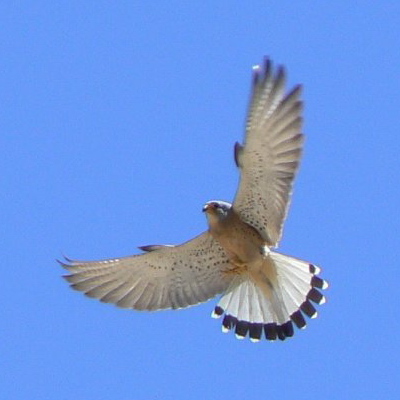m |
(add flight shot and re-format text) |
||
| Line 1: | Line 1: | ||
;Falco naumanni | ;Falco naumanni | ||
| − | [[Image:Lesser_Kestrel.jpg|thumb| | + | [[Image:Lesser_Kestrel.jpg|thumb|500px|right|Photo by ricardo g<br />Location: Castro Verde, Alentejo, Portugal]] |
| + | [[Image:Lesser_Kestrel_in_flight.jpg|thumb|400px|right|Photo by sevillek<br />Male photographed in: Alora, Andalucia]] | ||
| + | |||
| + | ==Description== | ||
| + | Size: 29-32 cm (11.5-12.3 in); wingspan: 58-72 cm (23-28.5 in). | ||
==Identification== | ==Identification== | ||
| − | Lesser Kestrel | + | The Lesser Kestrel is smaller than the Common (Eurasian) Kestrel and much scarcer. It is on the Critically Endangered List. |
| − | ( | + | ==Distribution== |
| − | + | Europe, Asia and Africa. Now rare and declining over most of European range. Breeds in central and southern Iberia, including Gibraltar, patchily in north-east Spain and southern France, Sardinia, Sicily and the southern tip of Italy and irregularly in South-East Europe. More widespread and numbers higher in Greece and Turkey and from the Ukraine and southern Russia east into Asia. In North Africa found in scattered parts of north Morocco, north Algeria and Tunisia and in the Middle East in Syria, possibly still Lebanon, Jordan and Israel although numbers have declined considerably. In many areas breeding is irregular or sporadic but numbers have increased in Portugal and southern France with the provision of nest-boxes. Breeding range extends westwards from the Caspian to western Sinkiang, Mongolia and Hopeh in northern China. | |
A summer visitor to most of breeding range, wintering throughout sub-Saharan Africa and India, rarely also Burma. Small numbers remain in winter in southern Spain, especially the Guadalquivir Valley, and also North Africa and southern Turkey. A broad-front migrant but regularly seen at Gibraltar. Most leave Europe August-September and return late February-April. | A summer visitor to most of breeding range, wintering throughout sub-Saharan Africa and India, rarely also Burma. Small numbers remain in winter in southern Spain, especially the Guadalquivir Valley, and also North Africa and southern Turkey. A broad-front migrant but regularly seen at Gibraltar. Most leave Europe August-September and return late February-April. | ||
Vagrants recorded north to Britain, the Netherlands, Denmark, Norway, Sweden and Finland also on the Canary Islands. British records (c.18) have occurred mainly in spring and have ranged from the Isles of Scilly north to Fair Isle. In the east recorded as a vagrant on Tsushima Island, Japan. | Vagrants recorded north to Britain, the Netherlands, Denmark, Norway, Sweden and Finland also on the Canary Islands. British records (c.18) have occurred mainly in spring and have ranged from the Isles of Scilly north to Fair Isle. In the east recorded as a vagrant on Tsushima Island, Japan. | ||
| + | ==Taxonomy== | ||
| − | + | ==Habitat== | |
| − | + | Dry open country, semi-desert, grassland and cultivated land. Also in rocky gorges and on ruined buildings. Colonial breeder, sometimes in towns. | |
| − | + | ==Behaviour== | |
| + | Feeds mainly on insects. | ||
==Bird Song== | ==Bird Song== | ||
<flashmp3>Falco naumanni (song).mp3</flashmp3><br /> | <flashmp3>Falco naumanni (song).mp3</flashmp3><br /> | ||
''[[Media:Falco naumanni (song).mp3|Listen in an external program]]'' | ''[[Media:Falco naumanni (song).mp3|Listen in an external program]]'' | ||
==External Links== | ==External Links== | ||
| − | + | {{GSearch|Falco+naumanni}} | |
[[Category:Birds]] | [[Category:Birds]] | ||
Revision as of 20:29, 9 June 2007
- Falco naumanni
Description
Size: 29-32 cm (11.5-12.3 in); wingspan: 58-72 cm (23-28.5 in).
Identification
The Lesser Kestrel is smaller than the Common (Eurasian) Kestrel and much scarcer. It is on the Critically Endangered List.
Distribution
Europe, Asia and Africa. Now rare and declining over most of European range. Breeds in central and southern Iberia, including Gibraltar, patchily in north-east Spain and southern France, Sardinia, Sicily and the southern tip of Italy and irregularly in South-East Europe. More widespread and numbers higher in Greece and Turkey and from the Ukraine and southern Russia east into Asia. In North Africa found in scattered parts of north Morocco, north Algeria and Tunisia and in the Middle East in Syria, possibly still Lebanon, Jordan and Israel although numbers have declined considerably. In many areas breeding is irregular or sporadic but numbers have increased in Portugal and southern France with the provision of nest-boxes. Breeding range extends westwards from the Caspian to western Sinkiang, Mongolia and Hopeh in northern China.
A summer visitor to most of breeding range, wintering throughout sub-Saharan Africa and India, rarely also Burma. Small numbers remain in winter in southern Spain, especially the Guadalquivir Valley, and also North Africa and southern Turkey. A broad-front migrant but regularly seen at Gibraltar. Most leave Europe August-September and return late February-April. Vagrants recorded north to Britain, the Netherlands, Denmark, Norway, Sweden and Finland also on the Canary Islands. British records (c.18) have occurred mainly in spring and have ranged from the Isles of Scilly north to Fair Isle. In the east recorded as a vagrant on Tsushima Island, Japan.
Taxonomy
Habitat
Dry open country, semi-desert, grassland and cultivated land. Also in rocky gorges and on ruined buildings. Colonial breeder, sometimes in towns.
Behaviour
Feeds mainly on insects.
Bird Song
<flashmp3>Falco naumanni (song).mp3</flashmp3>
Listen in an external program





